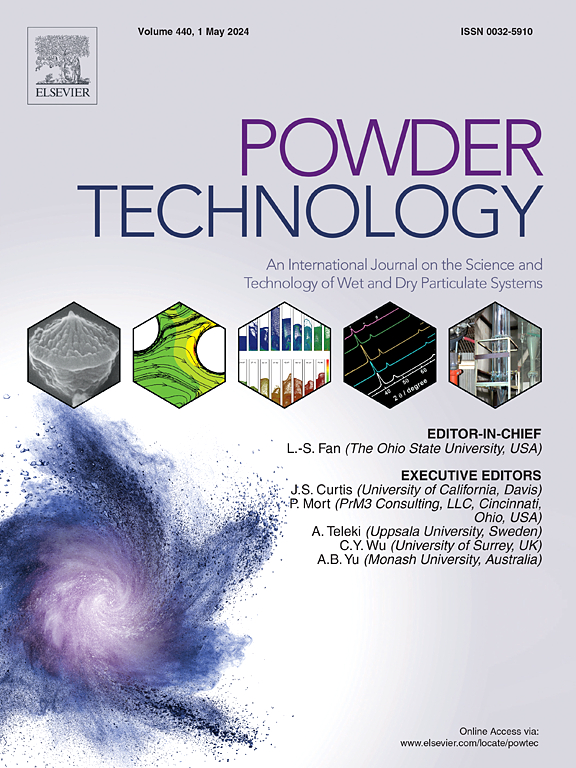Multi-stage agglomeration phenomena and properties of titania nanoparticle agglomerates in a lab-scale conical fluidized bed: Evaluation of CFD-DEM simulation by laser-based planar imaging and pressure fluctuation analysis
IF 4.5
2区 工程技术
Q2 ENGINEERING, CHEMICAL
引用次数: 0
Abstract
Understanding the agglomeration characteristics of nanoparticles (NPs) helps to improve their fluidization quality. This study aims to ascertain the multi-stage agglomeration of titania NPs in a conical fluidized bed. Fluidization experiments were performed to identify the temporal variation of particle size distribution and pressure fluctuations in different bed zones. A model was built by coupling computational fluid dynamics and discrete element method to ascertain the agglomerate characteristics that could not be identified by experiments. The results showed that the type of flow regime and position of particles in the radial direction have a significant impact on the agglomerate size, particle collision, and therefore bed pressure fluctuations. Primary types of simple-agglomerates (∼25–75 μm) and complex-agglomerates (∼100–150 μm) were mainly detected in the spout and annular zones, respectively. In full fluidization, a continuous break-up of primary complex-agglomerates into secondary simple-agglomerates (∼75–100 μm in size), and re-agglomeration of secondary simple-agglomerates into secondary complex-agglomerates (∼150–200 μm in size) occurred mainly in the annular and spout zones, respectively. In the heterogeneous fluidization, primary types of agglomerates were primarily detected in the spout zone and spout-annulus interface. The highest and lowest pressure fluctuations were obtained in the spout and annular zones, respectively, which was attributed to the effect of particle agglomeration. An increase in the particle cohesion force led to an increase in the probability of complex-agglomerates, as well as a notable deterioration in particle mixing. The effect of particle collision and deagglomeration on particle mixing was much more severe in the annular zone than in both the spout zone and the spout-annulus interface. Inelastic collisions between complex-agglomerates in the annular zone induce a loss in the kinetic energy and granular temperature, with this energy being enough to form secondary-agglomerates, but not enough to break them up, thereby postponing particle mixing.

求助全文
约1分钟内获得全文
求助全文
来源期刊

Powder Technology
工程技术-工程:化工
CiteScore
9.90
自引率
15.40%
发文量
1047
审稿时长
46 days
期刊介绍:
Powder Technology is an International Journal on the Science and Technology of Wet and Dry Particulate Systems. Powder Technology publishes papers on all aspects of the formation of particles and their characterisation and on the study of systems containing particulate solids. No limitation is imposed on the size of the particles, which may range from nanometre scale, as in pigments or aerosols, to that of mined or quarried materials. The following list of topics is not intended to be comprehensive, but rather to indicate typical subjects which fall within the scope of the journal's interests:
Formation and synthesis of particles by precipitation and other methods.
Modification of particles by agglomeration, coating, comminution and attrition.
Characterisation of the size, shape, surface area, pore structure and strength of particles and agglomerates (including the origins and effects of inter particle forces).
Packing, failure, flow and permeability of assemblies of particles.
Particle-particle interactions and suspension rheology.
Handling and processing operations such as slurry flow, fluidization, pneumatic conveying.
Interactions between particles and their environment, including delivery of particulate products to the body.
Applications of particle technology in production of pharmaceuticals, chemicals, foods, pigments, structural, and functional materials and in environmental and energy related matters.
For materials-oriented contributions we are looking for articles revealing the effect of particle/powder characteristics (size, morphology and composition, in that order) on material performance or functionality and, ideally, comparison to any industrial standard.
 求助内容:
求助内容: 应助结果提醒方式:
应助结果提醒方式:


